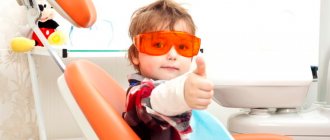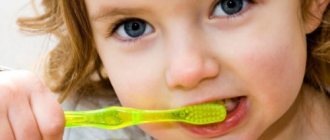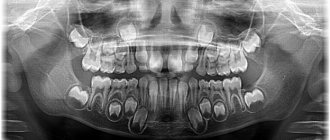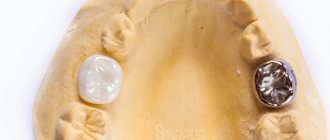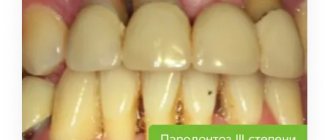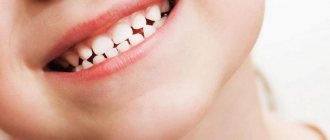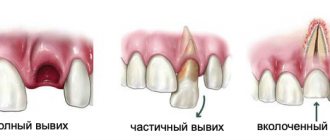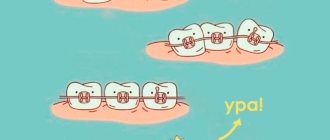How to Reduce Teething Pain
Fever and pain can be reduced by:
- massage the gums where tooth eruption is expected;
- the gums can be lubricated with an anesthetic;
- give the child a vasoconstrictor if the child has a runny nose;
- if the temperature rises above +38C, then the child should be given an antipyretic in the form of a sweet syrup.
Usually, the eruption of baby teeth occurs without complications. In some cases, a complication may occur that is caused by:
- Presence of a dental cyst.
- When the baby tooth has not yet come out, but it is supported by a permanent tooth.
- When a fang erupts, it is out of place in the dentition.
How to determine by symptoms that a child is getting his first fang
Symptoms can be detected much earlier than the baby’s first fangs appear. Usually parents notice them a few weeks before the teeth erupt, but there are also cases when symptoms appear even earlier. How can you tell if your child is growing fangs?
- The baby becomes irritable, his mood changes for the worse. He is capricious and crying.
- Parents notice strong salivation, sometimes leading to a runny nose or causing a cough.
- The gum swells and changes color where the fang erupts. The fang first appears as a small white dot located under the baby's gum.
- The child does not want to eat, sometimes he categorically refuses to eat.
- The baby doesn't sleep well.
- He often chews on various objects, trying to make them come into contact with his gums.
In addition to the above signs, parents may also observe an increase in temperature when the child begins to grow fangs. In some cases it rises to 38 degrees Celsius. The baby's stool becomes liquefied due to increased salivation. Excessive salivation also leads to vomiting.
Eye teeth in older children
Permanent eye teeth erupt in children aged 9-12 years. Normal eye tooth eruption should occur painlessly. If pain still bothers the child, it may be caused by:
- the presence of infection in the oral cavity;
- periodontal disease;
- development of dental caries.
The eye teeth may erupt in a crooked manner. Orthodontic treatment helps correct abnormal tooth growth. If a tooth erupts and grows incorrectly, it is removed on the advice of a dentist. After removing an eye tooth, it must be immediately replaced with a prosthetic so as not to disrupt the integrity of the dentition and not to impair the process of chewing food.
How to help your child during teething
The period of teething is considered difficult for the baby and requires special indulgence, attention and care for him. Therefore, it is important to help your child get through this difficult time for him. The process of cutting through the fangs located in the top row can be called especially painful. After all, they are located near the facial nerves. When the top row of canines erupt, tears actively flow from the baby’s eyes. His parents notice that he has some symptoms of conjunctivitis.
Now in children's stores and pharmacies you can buy toys - teethers, produced specifically to facilitate the process of cutting fangs. Manufacturers fill them either with water or use a gel for this purpose. The purchased toy can be placed in the refrigerator for a few minutes and cooled; it will soothe the baby’s gums and relieve itching. Parents will also benefit from pacifiers that the baby can chew; it is better to choose arthodontic ones. You can also buy special medications at the pharmacy that relieve some symptoms. For example, a gel with an anti-inflammatory effect, which ultimately reduces the baby’s pain. But you should not select any medications on your own without first consulting a specialist. If the child’s temperature rises to 38 degrees Celsius, then after consultation with the pediatrician, you can give him medicine with paracetamol. Ibuprofen may be a good alternative. These medications are considered safe for the baby and effectively fight fever. For children under 3 years old, it is better to buy medicines in the form of suppositories or syrups. Suppositories have an effect slower than syrup, but their effect lasts longer.
How to reduce pain in an eye tooth using traditional medicine
Dental treatment of the eye tooth can be supplemented with treatment with traditional medicine. Typically, after visiting a dentist in a specialized clinic, they advise the following:
- Dissolve a teaspoon of baking soda or salt in a glass of warm water. Rinse your mouth with this solution several times a day.
- Prepare a decoction of medicinal herbs: chamomile, sage, or make an infusion of oak bark. Rinse your mouth with prepared decoctions and infusions several times a day.
The eruption of eye teeth in children should occur under the supervision of a pediatric dentist. Adults who have problems with their eye teeth should also see a dentist.
Prevention measures
It is important for mothers to remember that a child’s health begins in the womb.
After all, the baby’s teeth are formed during pregnancy. It has long been proven that the more the expectant mother takes care of her health during pregnancy, the stronger her child’s teeth will be. Doctors advise pregnant women to eat seafood, milk, kefir, and cheese. If a gynecologist advises you to buy a special vitamin complex containing calcium, you should not neglect this advice. A lack of calcium in a child’s body causes dental problems. Caring mothers go through life with the correct motto “a happy baby is a healthy baby.” This article is for informational purposes only, please consult your doctor for details! Ask your doctor about contraindications and side effects.
Possible problems
Despite the fact that changing teeth is a natural physiological process, some children and their parents may encounter a number of problems that require contacting a pediatric dentist.
No molars
The absence of permanent units can be caused by congenital edentia - the complete or partial absence of tooth buds.
Another reason for the absence of molars is previous inflammatory diseases - periostitis or periodontitis, resulting from progressive caries. Inflammatory diseases of the periosteum and periodontal tissues have an extremely negative effect on the condition of the tooth buds and can lead to their death.
Important! It is absolutely necessary to treat baby teeth for caries. You should not assume that the problem will go away on its own with the change of teeth. The progression of the disease can negatively affect the health of the tooth buds.
Molar tooth hurts
The enamel of newly emerging permanent teeth is still poorly formed. The low level of its mineralization makes teeth vulnerable to cariogenic microflora. This can lead to the development of caries and cause pain.
Due to poorly formed enamel, tooth sensitivity to external irritants (cold, hot, sour, sweet) may increase, which is also accompanied by painful sensations.
Important! Normally, permanent teeth do not hurt. If pain occurs, you should contact your pediatric dentist. The specialist will determine the cause of the pain, carry out the necessary treatment, fluoridation or remineralization of tooth enamel.
Molars grow crooked
The incorrect position of permanent teeth can be caused by two reasons - the growth of the permanent unit outpaces the process of loss of baby teeth or they were removed ahead of schedule, which led to incorrect formation of the rudiments of permanent teeth.
In this case, there is only one way out - orthodontic treatment of malocclusion.
Important! A malocclusion must be corrected. The sooner you contact a dentist, the more successful the treatment will be. The child will be prescribed to wear removable or fixed orthodontic appliances that will help straighten the permanent teeth and bite.
Injuries
Due to their activity and lack of experience, children can accidentally injure a newly emerging permanent tooth. Due to mechanical damage, cracks and chips may appear on it. The damage looks unattractive. Caring for such teeth is complicated, since food debris can get stuck in the cracks, which will certainly lead to the development of caries.
Important! If a child accidentally injures a permanent tooth, it is necessary to seek help from a dentist. The specialist will assess the complexity and depth of the damage and will build up the missing volume of tooth tissue with composite materials.
Tooth loss
Loss of healthy permanent teeth can only occur as a result of severe trauma to the jaw, for example, during a child’s fall or fight. A diseased molar may fall out on its own. In this case, you will also need to consult a specialist. Most likely, the child will undergo temporary prosthetics for the lost unit, which will not disrupt the formation of a correct permanent bite.
The tooth is loose
Looseness of a permanent tooth is an alarming symptom indicating a pathology of the dentofacial apparatus or the presence of inflammation. Consultation with a specialist is required!
Formation of permanent teeth
Molars are formed from the epithelial dental plate. The appearance of their rudiments occurs only closer to the 5th month of fetal development inside the mother’s womb.
There are two groups of molars:
- Substitutes. This includes canines, incisors and premolars, which have temporary analogues.
- Additional. This group includes molars that do not have milk predecessors.
The growth of the primordial teeth of the replacement type occurs in the same alveolus as the temporary teeth; they are located behind the lingual surface of the primary teeth. Only after some time does the volume of bone tissue increase, ensuring their insulation.
Additional teeth are formed only after a year, since for this the jaw must reach the appropriate size.
What does a dental formula look like?
To make it more convenient to describe teeth and their number, special formulas are usually used. Each tooth has its own number, which is used to decipher its location.
When describing a milk bite, Roman numerals are used:
- incisors – I, II;
- canine – III;
- molars – IV, V.
If we talk about the formula for adult teeth, here the teeth are counted starting from the center:
- incisors – 1.2;
- fang – 3;
- molars (small) – 4.5;
- molars (large) – 6,7,8.
8 is a wisdom tooth; not every person has it.
In what cases may they appear earlier/later and why?
If at least one tooth has grown by the age of one year, there is no reason to worry.
According to statistical data, in modern babies the period of eruption of the first teeth differs slightly from generally accepted normative indicators. White surfaces of the incisors are observed from 8.5 months of age.
Accordingly, the process of replacing dairy units with permanent units is also shifting. Pediatric dentists do not see any problems if by the age of one year the child has at least one tooth , and by the age of three the entire milk group has been formed.
In the complete absence of units, a thorough examination of the baby is carried out to identify provoking factors.
A discrepancy in the timing of teething may be due to a genetic factor or other reasons. Among the main provocateurs of process delays:
- previous infectious diseases;
- disruption of the gastrointestinal tract that occurred over a long period of time;
- problems with the metabolic functions of the body;
- lack of vitamin D (when diagnosing rickets);
- pituitary insufficiency.
It is not only the late teething that is alarming, but also their earlier appearance. Most often this occurs as a result of a disorder of the endocrine system (for example, Albright's syndrome, hyperthyroidism, hypergonadism).
A growing tumor (for example, eosinophilic granuloma) can provoke the eruption of one or a whole group of incisors before the age of six months.
Possible complications
"Surprises"
The problems that nature presents when infants have their first teeth do not end with the listed troubles. Sometimes other complications are possible:
- Formation of hematomas.
A bluish-colored bubble swells on the gum. Most often it resolves over time, but sometimes if the blister is too large, surgery is required. The doctor makes a small incision on the gum to remove the bloody fluid.
- The appearance of vomiting.
This may be caused by excessive salivation. However, if vomiting is accompanied by diarrhea and fever, these may be signs of rotavirus, so it is necessary to urgently show the child to the pediatrician.
- Cough reflex.
With normal teething it does not happen. The cause of the cough may be excessive saliva secretion, which causes the baby to choke.
If a runny nose appears, take your child to the doctor
- teething probably coincided with a cold.
Important:
If your baby is experiencing fever, diarrhea and vomiting during teething, take this seriously. The cause of their appearance cannot be teething. It is urgent to call a pediatrician, since the baby’s body is at risk of intoxication due to a developing infection.
Features of baby teeth
Now I will answer another very popular question: “how do baby teeth differ from molars?”
These are the baby's very first teeth. They appear before the age of three, and begin to erupt until there are 20 teeth. See the photo above for the cutting diagram.
They do not have such deep roots as permanent teeth, have a more rounded shape and smaller size, and are white in color, while permanent teeth have a yellowish tint. By location, they are directed vertically, and the radicals are slightly outward.
Wisdom teeth cannot be milk teeth, because they grow into deep roots only by the age of 18-20, and sometimes later.
Duration of growth
Typically, children say goodbye to their last temporary teeth at about 12-13 years of age, although the roots of baby teeth dissolve even earlier. By that time, the oral cavity already has molars that are actively growing, and their roots are at different stages of formation.
It is necessary to understand the approximate timing of growth and root formation in case of deviations. It is these indicators that are taken into account when choosing a treatment method.
Experts distinguish two main stages of development of the roots of permanent teeth:
- Stage of unformed apex.
- Unclosed apex stage.
At the first stage, the length of the root becomes maximum, but its walls are parallel to each other. The channel is of sufficient width; it ends in the area of the future apex with a bell. The periodontal gap can be seen only on the sides of the tooth root.
At the next stage, there is a gradual formation of the upper part of the root, the convergence of the root walls and the release of the periodontal fissure, the apical region of which is slightly enlarged.
Doctor's advice when the process of changing teeth begins:
- After tooth loss, let your baby not eat for 3 hours, and you should also not drink very cold or hot drinks.
- Protect your child from sour, spicy and very sweet, astringent foods. All this has a negative impact on teeth.
- If your baby is bothered by discomfort or pain after a baby tooth falls out, then buy a special gel, but it is better to choose it on the recommendation of a dentist.
- Do not let your child touch the hole where a tooth has fallen out, as it may become infected.
- To soothe your mouth, make a decoction of chamomile.
